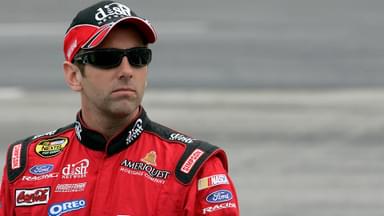As per the latest NASCAR format, the driver who wins the final race [at Phoenix] of the season clinches the championship. As per Greg Biffle, if this format had been in place in 2004, 2005, and 2006, he might have secured at least three Cup championships, given his strong performances in those season finales.
Advertisement
Reflecting on what might have been, Biffle recently shared a nostalgic post on social media, featuring a photo of his car crossing the finish line at the 2006 Homestead race.
The accompanying text reminisced, “Greg Biffle won the 2005 Ford 400 at Homestead-Miami 19 years ago today. He beat his teammate Mark Martin by .017 seconds for the win. Teammates Matt Kenseth and Carl Edwards finished 3rd and 4th.”
Biffle added a caption to his post, “Wish this format existed back then… a couple years in a row…bummer.”
Wish this format existed back then… a couple years in a row…bummer https://t.co/PVWeY17dBn
— Greg Biffle (@gbiffle) November 22, 2024
Fans also rallied behind their favorite driver, with one highlighting that if he won the Cup championship back then, Biffle would have become the only driver to have won championships in all three NASCAR formats.
He won the 2002 NASCAR Busch Series Championship [now called the Xfinity Series championship] and the 2000 NASCAR Craftsman Truck Series Championship.
The fan mentioned, “Totally agree. If they had used the traditional points method, you would have been the FIRST and ONLY driver to have been Champion of all three of NASCAR’s top series. If there is ever a case for “Highway Robbery”, it is that. Once a Biffle fan, ALWAYS a Biffle fan.”
Another fan praised the former Roush Racing driver’s dominance at Homestead in the mid-2000s, saying, “You had Homestead covered in the mid-2000s, head and shoulders above the rest of the field.” Meanwhile, another speculated, “My first thought when this system was created was dang Biffle would’ve been Jimmie before there was Jimmie.”
Currently, several racers including Joey Logano and Denny Hamlin are advocating for changes to the format. Logano has proposed that the championship venue should rotate like the Super Bowl, suggesting it include not just ovals but road courses as well, to spice up the competition.
Hamlin, on the other hand, has suggested that the championship should consist of a series of races, perhaps a round of three, instead of a single decisive race.
Multiple iterations of NASCAR’s playoff format
Initially, in 2004, the format encompassed the first 26 races of the season. Drivers in the top 10 and those within 400 points of the leader qualified for the chase, competing in the final 10 races to have points in pursuit of the championship, emphasizing the need for consistency.
The format underwent its first major revision in 2007 when NASCAR expanded the chase field to the top 12 drivers based on the points standings after the first 26 races.
Further changes were implemented in 2011, tweaking the chase format and the points system for winnings. After the 26 regular season races, the top 10 drivers, based on points, would automatically advance to compete for the Cup championship.
An overhaul was introduced on January 30, 2014, during Media Day, adopting a chase system more akin to the playoff systems in other major sports. The change expanded the playoff field to 16 drivers for the 10-race chase, selecting contenders based on wins during the regular season, with the remaining slots filled based on points if fewer than 16 drivers won races.
The most recent update, announced on January 23, 2017, by NASCAR chairman and CEO Brian France, introduced a revised points system for the regular season. Races were divided into three stages: Stages 1 and 2 constitute approximately a quarter of the laps each, with Stage 3 making up about half of the race.
The final change was the finale race setting; initially held at Homestead, it was moved to Phoenix, where the top four drivers battle it out for the championship in a winner-takes-all finale.




